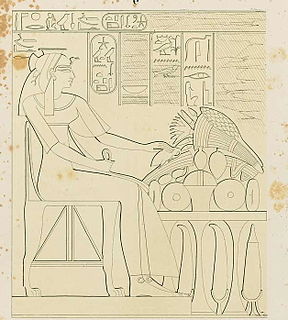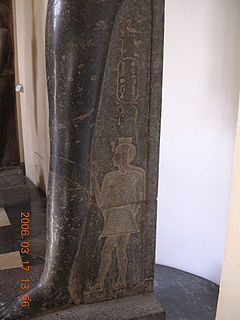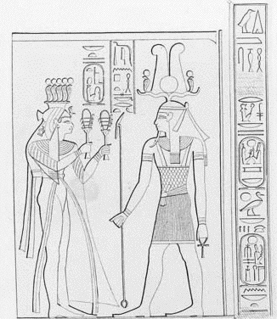This page is based on this
Wikipedia article Text is available under the
CC BY-SA 4.0 license; additional terms may apply.
Images, videos and audio are available under their respective licenses.

Neferkare Ramesses IX was the eighth king of the Twentieth dynasty of Egypt. He was the third longest serving king of this Dynasty after Ramesses III and Ramesses XI. He is now believed to have assumed the throne on I Akhet day 21 based on evidence presented by Jürgen von Beckerath in a 1984 GM article. According to Papyrus Turin 1932+1939, Ramesses IX enjoyed a reign of 18 Years and 4 months and died in his 19th Year in the first month of Peret between day 17 and 27. His throne name, Neferkare Setepenre, means "Beautiful Is The Soul of Re, Chosen of Re." Ramesses IX is believed to be the son of Mentuherkhepeshef, a son of Ramesses III since Montuherkhopshef's wife, the lady Takhat bears the prominent title of King's Mother on the walls of tomb KV10 which she usurped and reused in the late 20th dynasty; no other 20th dynasty king is known to have had a mother with this name. Ramesses IX was, therefore, probably a grandson of Ramesses III.

Khepermaatre Ramesses X was the ninth ruler of the 20th dynasty of Ancient Egypt. His birth name was Amonhirkhepeshef. His prenomen or throne name, Khepermaatre, means "The Justice of Re Abides."

Menmaatre Ramesses XI reigned from 1107 BC to 1078 BC or 1077 BC and was the tenth and final pharaoh of the Twentieth dynasty of Egypt and as such, was the last king of the New Kingdom period. He ruled Egypt for at least 29 years although some Egyptologists think he could have ruled for as long as 30. The latter figure would be up to 2 years beyond this king's highest known date of Year 10 of the Whm Mswt era or Year 28 of his reign. One scholar, Ad Thijs, has even suggested that Ramesses XI reigned as long as 33 years—such is the degree of uncertainty surrounding the end of his long reign.

Pinedjem I was the High Priest of Amun at Thebes in Ancient Egypt from 1070 to 1032 BC and the de facto ruler of the south of the country from 1054 BC. He was the son of the High Priest Piankh. However, many Egyptologists today believe that the succession in the Amun priesthood actually ran from Piankh to Herihor to Pinedjem I.

Takhat was an ancient Egyptian princess and queen of the 19th dynasty, the mother of the Twosret and the usurper pharaoh Amenmesse.

Masaharta or Masaherta was the High Priest of Amun at Thebes between 1054 and 1045 BC.

Duatentopet or Tentopet was an Ancient Egyptian queen of the 20th dynasty, the wife of Pharaoh Ramesses IV, and mother of Ramesses V. Even though the identity of Ramesses IV's wife has not been clearly stated in history, she is considered the most likely candidate by virtue of the titles she was given and which were found listed in her tomb (QV74).

Henutmire was an Ancient Egyptian princess and queen. She was one of the eight Great Royal Wives of Pharaoh Ramesses II of the 19th Dynasty of Egypt.

Iset Ta-Hemdjert or Isis Ta-Hemdjert, simply called Isis in her tomb, was an Ancient Egyptian queen of the twentieth dynasty; the Great Royal Wife of Ramesses III and the Royal Mother of Ramesses VI.

Baketwernel was an ancient Egyptian queen during the 20th Dynasty. She is likely to have been the Great Royal Wife of Ramesses IX.

Duathathor-Henuttawy, Henuttawy or Henttawy ("Adorer of Hathor; Mistress of the Two Lands") was an ancient Egyptian princess and later queen.

Iset (Aset, Isis) was an ancient Egyptian princess and God's Wife of Amun during the 20th Dynasty.
Nubkhesbed was an ancient Egyptian queen of the 20th dynasty. She was the Great Royal Wife of Pharaoh Ramesses VI and mother of Pharaoh Ramesses VII, Princess Iset and Princes Amenherkhepshef and Panebenkemyt.
Meritamen, also spelled Meritamun, Merytamen, Meryetamen is an ancient Egyptian female name. Its male counterpart is Meryamen or Meryamun.
Tyti was an ancient Egyptian queen of the 20th dynasty. A wife and sister of Ramesses III and possibly the mother of Ramesses IV.
Meritites, also spelled Meryetites, Meritates, etc. (mr.t-ỉt=s; “beloved of her father”) was an ancient Egyptian female name. Its notable bearers were:
Isetnofret (3s.t-nfr.t; also spelled as Isetneferet, Isisnofret etc.) was an ancient Egyptian female name, meaning “Isis is beautiful”.












